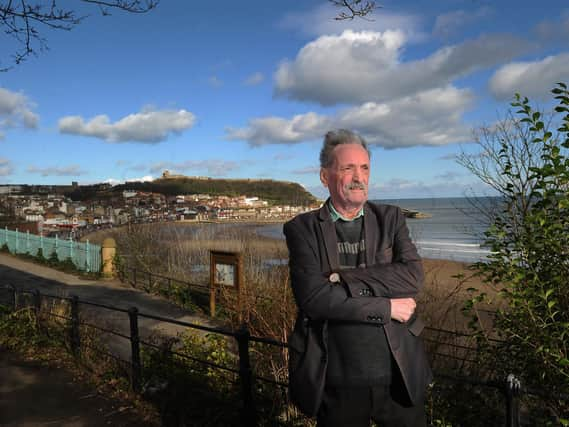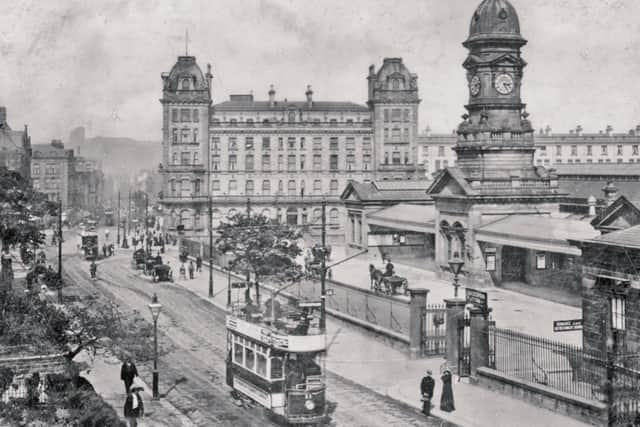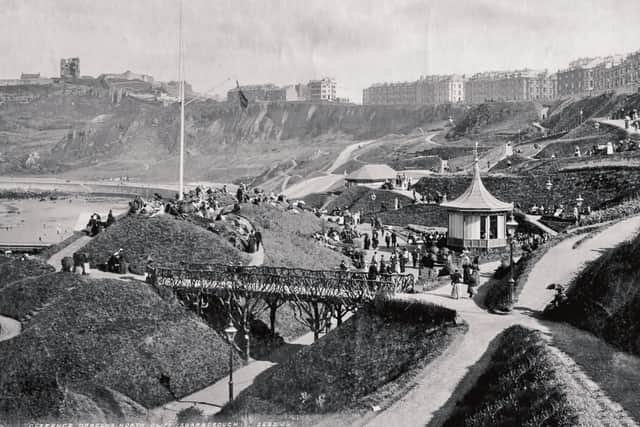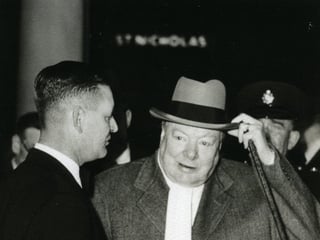On a history tour of Scarborough with a new book about the seaside town


“Dear All, Weather very good so far. I am keeping my fingers crossed for the rest of the week. We have good company in the hotel. Love Violet.”
On the front of the card – one of half a dozen I picked up at a Scarborough charity shop a few years ago – are pictures of Peasholm Park, the North Bathing Pool, the harbour and the South Bay of the resort famously celebrated as “Queen of the Yorkshire Coast”.
Advertisement
Hide AdAdvertisement
Hide AdI’ve brought the postcards with me to show Mike Hitches, author of Scarborough History Tour, a new pocket guide to the town’s attractions. Hitches, a former sociology lecturer based in Filey, has devised a walk, with a crisp commentary and vintage photographs. Pointing out both familiar and unfamiliar buildings, it’s an interesting chance to compare “then” and “now”, though you may need a magnifying glass (or eyesight better than mine) to follow the map.


Nevertheless, tour book in hand, and braced by the inlander’s need for the coast, I take off on a two-hour stroll, starting at the station. Tourism boomed when it opened in 1845 and brought crowds from all over the West Riding. Not everyone, however, was keen. “Scarborough has no wish for a greater influx of vagrants and those who have no money to spend,” sneered a local pamphleteer.
So where might the vagrants have come from? The station’s Edwardian tile map of the North Eastern Railway’s network shows a spider’s web of lines linking Scarborough with practically every Yorkshire village, every hamlet, every cowshed. You could get here from stations at Cloughton, Hayburn Wyke and Staintondale; from Forge Valley, Wykeham and Snainton; from Ganton, Weaverthorpe and Heslerton.
The station gets a good showing in the book. Rail enthusiasts will enjoy its photographs of classic engines, some painstakingly identified (“Ex-LNER Class D49 4-4-0 steam locomotive No 62735 Westmorland… Ex-LNER A8 Class 4-6-2 tank engine No 69886”). A must-read for the trainspotters with notebooks and shoulder bags who cluster on York and Doncaster stations.


Advertisement
Hide AdAdvertisement
Hide AdScarborough station’s frontage has hardly changed since Edwardian days. But, as one of the book’s pictures shows, the surrounding area has. A grand Victorian pile across the road has given way to concrete-slab architecture. Many older buildings survive on Westborough, the main shopping street, but some stretches are dispiritingly different from its elegant Edwardian days of parasols and horse-drawn charabancs. Not a newcomer’s best introduction to the delights of the resort.
For one of which, I turn down Huntriss Row and toy with afternoon tea at Bonnets, one of the most treasurable of Scarborough cafes. Nearly 20 years on, I still remember the toasted cinnamon tea cakes I had here. But I must get on.
Number five on the tour is the Grand Hotel – “a High Victorian gesture of assertion and confidence (and) denial of frivolity” as Nikolaus Pevsner, the architectural guru, called it. Once Europe’s biggest hotel, the Grand is so vast, so architecturally serious, that it looks like a German spa hotel unaccountably set adrift in the North Sea and washed up on the Yorkshire coast.
Built on the site of the house where Anne Brontë died, it once boasted 365 rooms. You could stay a full year, with the guarantee of a different view every morning. You’d reach them on the grandest of grand staircases, designed for extravagant “Ready for you now, Mr de Mille” descents.
Advertisement
Hide AdAdvertisement
Hide AdStatues of Grecian maidens lurk behind bingo adverts. Soft background music plays wistfully in the Java Lounge as couples do their crosswords. I consider afternoon tea here too, but the sun has come out and the seagulls are screeching. On a fine winter’s day, the seaside is at its most exhilarating and I need to go promenading.
Where better than along the pedestrian Spa Bridge (“quite thrilling to see,”according to Pevsner). From the bridge’s lofty vantage point, the whole South Bay panorama opens out, a great sweep of holiday pleasure. Down below, dog-walkers and rucksacked ramblers stride along the shining wet sands and the tide slops and slushes.
Over on the left, the Old Town’s jumble of houses tumbles down the hill to the harbour, with the castle and St Mary’s church cresting the horizon.
Over on the right, the fascinating Rotunda museum (curiously not included in the book) perches like a giant biscuit barrel.
Advertisement
Hide AdAdvertisement
Hide AdBut I’m off down to the Spa, which is quiet today and not echoing with the sounds of the Spa Orchestra, Britain’s last seaside orchestra. The new season opens on June 1, long after its most famous conductors, Alick Maclean and Max Jaffa, passed to the great Palm Court in the sky, serenaded by angels humming Bells Across the Meadow and selections from White Horse Inn.
A 1934 holiday brochure enthused about the Spa’s “very continental” atmosphere: “Only at Monte Carlo can one find anything approaching the splendour of its setting.”
Unsurprisingly, the Spa was a major focus of 30s and 40a railway posters, which projected a glamorous, sophisticated image possibly ever-so-slightly out of kilter with reality. They show suave, moneyed middle-class people in trim striped blazers and gay sun hats lounging languidly as they watch fellow holiday-makers diving into a swimming pool. “What time are we going for cocktails, darling?”
The postcards I’ve brought with me tell a more down-to-earth story. Back in 1964, “Lily” sent friends living near Oldham a card featuring the Italian Gardens: “Having a very nice time. Plenty of good food and lots of people here. Weather fine but dull.”
Advertisement
Hide AdAdvertisement
Hide AdTwo years earlier, Ken, Lily and Daniel in Woodford Green, Essex, received a card showing Scarborough’s two bays. “It was lovely hot and sunny yesterday,” was the unsigned message in pink ball-point pen. “But now it is dull and chilly.”
Today, outside the Spa, two shawl-swathed women with woolly pom-pom hats huddle gamely on the front seat of an open-top bus. I set off back along the prom for a coffee at the Harbour Bar, that dazzling yellow shrine to the Knickerbocker Glory. But it starts to rain, so I take the Tramway for the short, steep rumble up the cliff.
Passing the old “Greensmith and Thackwray, Indian and Colonial Outfitters” sign over a coffee shop, I press on and ponder afternoon tea at the Conservatory Coffee Shop. But no, my train home leaves in 20 minutes.
I haven’t had time to follow Hitches’s tour to the North Bay to indulge in a bit of nostalgia with the book’s 60s picture of the Corner Cafe, a reliable refuge on rainy days. Or to spot the site of Scarborough’s short-lived Victorian pier, which collapsed on a stormy day in 1905.
Advertisement
Hide AdAdvertisement
Hide AdNo matter. I send myself a postcard instead. “Weather very good most of the afternoon, though it started raining. Had a lovely walk round, but didn’t manage afternoon tea. Wish I was here.”
And I make do with a tea from the station buffet.
Scarborough History Tour by Mike Hitches (Amberley Publishing, £7.99).
Amberley have also recently published A-Z of Whitby: Places-People-History by Ian Thompson and Roger Frost (£14.99). It covers a broad swathe of the town’s culture and character with plenty of out-of-the-way information. If the Court of Piepowders and the Order of the Holy Paraclete are new to you, the book will explain.
